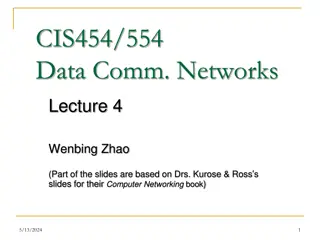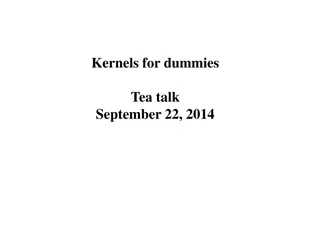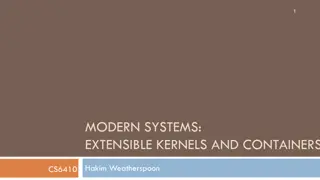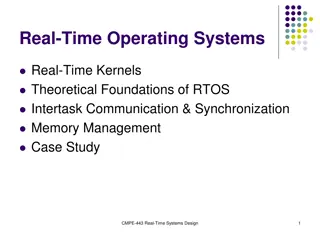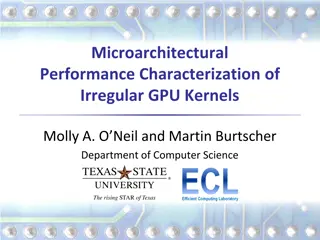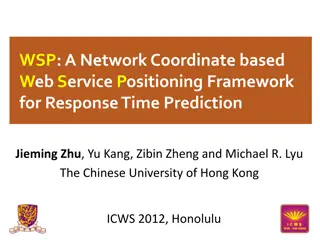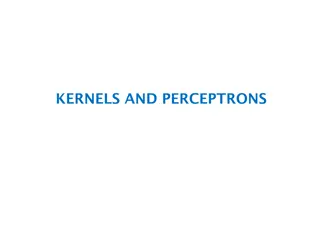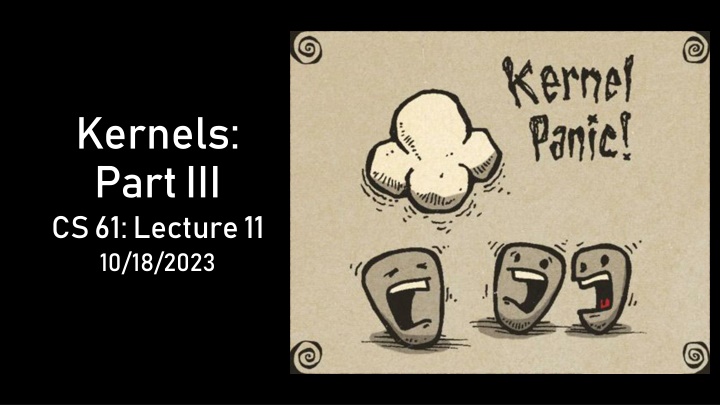
Virtual Memory and Memory Mapping in CPUs
Virtual memory and memory mapping play crucial roles in CPU operations. They allow CPUs to access physical memory indirectly through virtual addresses, managed by the kernel. Mapping virtual pages to physical pages enables efficient memory utilization. This article delves into the concepts of virtual memory, page tables, and memory mapping in CPUs like x86-64, highlighting the importance of indirection for memory access.
Download Presentation

Please find below an Image/Link to download the presentation.
The content on the website is provided AS IS for your information and personal use only. It may not be sold, licensed, or shared on other websites without obtaining consent from the author. If you encounter any issues during the download, it is possible that the publisher has removed the file from their server.
You are allowed to download the files provided on this website for personal or commercial use, subject to the condition that they are used lawfully. All files are the property of their respective owners.
The content on the website is provided AS IS for your information and personal use only. It may not be sold, licensed, or shared on other websites without obtaining consent from the author.
E N D
Presentation Transcript
Kernels: Part III CS 61: Lecture 11 10/18/2023
(2V)-1 (2V)-1 Static data Static data Virtual Memory: Basic Idea Don t let code (i.e., CPU instructions) access physical memory directly Instead, use indirection! CPU instructions manipulate virtual memory addresses in [0, (2V)-1] The kernel defines the mapping between virtual addresses and physical memory addresses in [0, (2P)-1] Kernel installs the appropriate virtual-to- physical mapping (the page table context-switching to a particular process A CPU s MMU hardware enforces the kernel-established mapping Physical memory addresses are what the CPU actually sends to the DRAM hardware //Return to user mode! iretq Code Code Heap+stack Other stuff Heap+stack Other stuff //k-exception.S _Z15exception_entryv: push %gs push %fs pushq %r15 Kernel memory User memory Kernel memory User memory pushq %r14 pushq %r13 pushq %r12 pushq %r11 //...and the other registers, //then do . . . movq %rsp, %rdi Stack Stack Heap Heap Static data Static data _Z16exception_returnP4proc: //Load the process's page table. movq (%rdi), %rax movq %rax, %cr3 Code Code 0 0 Process Y s virtual memory Process X s virtual memory page table) when (2P)-1 //Restore user-mode registers. leaq 16(%rdi), %rsp popq %rax popq %rcx popq %rdx //...pop other registers, then . . . //Load the kernel s page table. movq $kernel_pagetable, %rax movq %rax, %cr3 call _Z9exceptionP8regstate //`exception` should never return! 0 Physical RAM
Virtual Memory: Basic Idea User process Z User process Y User process X Kernel Don t let code (i.e., CPU instructions) access physical memory directly Instead, use indirection! CPU instructions manipulate virtual memory addresses in [0, (2V)-1] The kernel defines the mapping between virtual addresses and physical memory addresses in [0, (2P)-1] Kernel installs the appropriate virtual-to- physical mapping (the page table context-switching to a particular process A CPU s MMU hardware enforces the kernel-established mapping Physical memory addresses are what the CPU actually sends to the DRAM hardware MMU MMU MMU MMU Hardware page table) when RAM SSD UX devices Network Each CPU can potentially be using a different virtual-to- physical mapping!
Memory Mapping via Pages x86-64 CPUs (and other popular CPUs) map memory at a page page-size granularity Ex: On x86-64, the allowable page sizes are 4 KB, 2 MB, and 1 GB Ex: On RISCV32, the allowable page sizes are 4 KB and 4 MB Given a virtual page vx, a page table maps vx to some equally-sized physical page py (or none if vxdoesn t reside in physical memory) Any virtual page can map to any physical page! All addresses within a particular virtual page map linearly, at the same offsets, to the associated physical page Let bv be the base virtual address of a virtual page, and bp be the base physical address of the mapped physical page For any offset o within the virtual page, the MMU maps the virtual address bv+o to physical address bp+o Virtual memory for process X v v15 15 Physical memory v v9 9 v v1 1 v v15 15 o o MMU b bv v Somewhere in physical memory . . . Page table v v0 0 - -> p v v1 1 - -> p v v7 7 - -> p v v8 8 - -> p v v9 9 - -> p v v15 Virtual page > p0 0 > p6 6 > p1 1 > p3 3 > p7 7 > p5 5 v v9 9 v v8 8 v v7 7 o o b bp p Backing physical page v v8 8 v v7 7 v v0 0 15 - -> p v v1 1 v v0 0
Memory Mapping via Pages The largest possible virtual address space on a 64-bit chip contains 264 bytes (i.e., 17,179,869,184 GBs)! In practice, modern x86-64 chips only support 256,000 GB of virtual memory, which is still huge Physical RAM on a real computer is much smaller (e.g., 32 GB on a very nice laptop) So, even a single process could not fit all of its virtual pages into physical RAM Luckily, virtual address spaces are sparsely populated, i.e., most virtual pages aren t actually used A page table entry contains access permissions Is the virtual page actually p present in physical RAM? Is the page s data w writable? Is the page s data e execute-d disabled? Is the page accessible to u user-privileged code? Virtual memory for process X v v15 15 Physical memory v v9 9 v v1 1 v v15 15 MMU Page table v v0 0 - -> p v v1 1 - -> p v v7 7 - -> p v v8 8 - -> p v v9 9 - -> p v v15 > p0 0 > p6 6 > p1 1 > p3 3 > p7 7 > p5 5 v v9 9 v v8 8 v v7 7 v v8 8 v v7 7 v v0 0 15 - -> p access permissions The CPU generates a page fault if an instruction attempts to v v1 1 v v0 0 violate page permissions!
Address Translation in More Detail The virtual address is what is manipulated by software (i.e., by CPU instructions like mov 0x8(%rax), %rbx) The MMU takes the virtual address (e.g., whatever 0x8(%rax) resolves to) and: Extracts the v-bit virtual page number Uses the page table to convert the virtual page number to a p-bit physical page number Sends the physical address (of size p+o bits) to RAM Suppose that on a 12-bit CPU, v=8, p=4, and o=4; a possible mapping is: Physical Page Number Offset Virtual address Offset Virtual Page Number v bits o bits MMU p bits 8-bit virtual page number 12-bit Virtual address: 0xC98 8-bit Physical address: 0xA8 4-bit physical page number 4-bit offset Physical address
Case study: x86-64 L4 L3 L2 L1 Offset 47 39 30 38 21 29 20 12 11 0 Holds the physical address of a 4 KB-aligned PML4 Highest-order bits not useful for address translations! %cr3
Case study: x86-64 L4 L3 L2 L1 Offset 47 39 30 38 21 29 20 12 11 0 A 4 KB-aligned PDP has 512 8-byte entries A 4 KB-aligned PML4 has 512 8-byte entries %cr3 9 bits Bookkeeping stuff PDPTE 9 bits Page directory pointer PML4E PML4E PML4E 4KB-aligned PDPTE physAddr 64 bits Page map level 4 47 63 48 12 11 0
Case study: x86-64 L4 L3 L2 L1 Offset 47 39 30 38 21 29 20 12 11 0 A 4 KB-aligned PDP has 512 8-byte entries 9 bits PDE %cr3 9 bits Page directory Bookkeeping stuff PDPTE 9 bits A 4 KB-aligned PD has 512 8-byte entries Page directory pointer PML4E PDPTE PDPTE 4KB-aligned PDE physAddr 64 bits Page map level 4 47 63 48 12 11 0
Case study: x86-64 L4 L3 L2 L1 Offset 47 39 30 38 21 29 20 12 11 0 9 bits PDE %cr3 9 bits Page directory Bookkeeping stuff PDPTE 9 bits A 4 KB-aligned PD has 512 8-byte entries 47 48 63 Page directory pointer PML4E PDE PDE 4KB-aligned PTE physAddr 64 bits Page map level 4 12 11 0
Case study: x86-64 L4 L3 L2 L1 Offset 47 39 30 38 21 29 20 12 11 0 PhysAddr 12 bits 4KB page 9 bits PTE 9 bits Page table PDE User-mode accessible? Writeable? %cr3 9 bits A 4 KB-aligned PT has 512 8-byte entries Page directory PDPTE Present? 9 bits Page directory pointer PML4E PTE PTE 4KB-aligned physPage addr 64 bits Page map level 4 47 63 48 12 11 3 1 0 2
Why so many levels? Virtual address spaces are sparse! Ex: Most processes don t have gigabytes of code Ex: Most processes don t have gigabytes of stack frames Multi-level tables: only materialize entries for live parts of address space Ex: A single PML4E covers 512 GB If none of those addresses are in use, just set the PML4E.present bit to 0! Don t need to create PDP/PD/PT tables for the subtree 47 48 63 User-mode accessible? Writeable? Present? Bookkeeping stuff PML4E PML4E 4KB-aligned PDPTE physAddr 12 11 3 1 0 2
Paging: The Good and the Bad Good: A virtual address space can be bigger/smaller than physical memory Bad: A single virtual memory access now requires five physical memory accesses accesses five physical memory x86-64 physical memory accesses 1. Load entry from page map level 4 2. Load entry from page directory pointer 3. Load entry from page directory 4. Load entry from page table 5. Generate the real memory access
Translation Lookaside Buffers (TLBs) Idea: Cache some PTEs (i.e., virtual page to physical page translations) in a small hardware buffer If a virtual address has an entry in TLB, the CPU doesn t need to go to physical memory to fetch a PTE! If a virtual address misses in TLB, the CPU must walk the page table to fetch a PTE Key/value store: key is the virtual page number, and the value is the PTE TLB TLB RAM
Translation Lookaside Buffers (TLBs) Idea: Cache some PTEs (i.e., virtual page to physical page translations) in a small hardware buffer If a virtual address has an entry in TLB, the CPU doesn t need to go to physical memory to fetch a PTE! If a virtual address misses in TLB, the CPU must walk the page table to fetch a PTE TLBs are effective because programs exhibit locality Temporal locality When a process accesses virtual address x, it will likely access x again in the future Ex: a function s local variable that lives on the stack Spatial locality When the process accesses something at memory location x, the process will likely access other memory locations close to x Ex: reading elements from an array on the heap
The Lifecycle of a Memory Reference on x86 Virtual address TLB lookup Yes No TLB hit? HW walks the page table Check protection bits Yes No Access ok? Yes No Found PTE for virt frame? HW updates TLB HW raises a page fault HW raises a page fault Calculate phys addr, send to L1/L2/L3/RAM
The Lifecycle of a Memory Reference on x86 Virtual address Before raising a page fault exception, the CPU sets %cr2 to faulting address, and pushes an error code onto stack -Ex: User process tried to read a nnon-present page -Ex: User process tried to write aa present but read-only page TLB lookup Yes No TLB hit? HW walks the page table Check protection bits Yes No Access ok? Yes No Found PTE for virt frame? HW updates TLB HW raises a page fault HW raises a page fault Calculate phys addr, send to L1/L2/L3/RAM
//WeensyOS's x86-64.h //Paged memory constants #define PAGEOFFBITS 12 //# bits in page offset #define PAGEINDEXBITS 9 //# bits in a page index level #define PAGESIZE (1UL << PAGEOFFBITS) //Page size //in bytes //Page table entry definitions typedef struct __attribute__((aligned(PAGESIZE))) x86_64_page { uint8_t x[PAGESIZE]; } x86_64_page; typedef uint64_t x86_64_pageentry_t; typedef struct __attribute__((aligned(PAGESIZE))) x86_64_pagetable { x86_64_pageentry_t entry[1 << PAGEINDEXBITS]; } x86_64_pagetable;
//WeensyOS's x86-64.h //Paged memory constants #define PAGEOFFBITS 12 //# bits in page offset #define PAGEINDEXBITS 9 //# bits in a page index level #define PAGESIZE (1UL << PAGEOFFBITS) //Page size //in bytes //Page table entry definitions typedef struct __attribute__((aligned(PAGESIZE))) x86_64_page { uint8_t x[PAGESIZE]; } x86_64_page; typedef uint64_t x86_64_pageentry_t; typedef struct __attribute__((aligned(PAGESIZE))) x86_64_pagetable { x86_64_pageentry_t entry[1 << PAGEINDEXBITS]; } x86_64_pagetable;
WeensyOS: Memory-related Constants //WeensyOS does not support physical memory //addressing beyond MEMSIZE_PHYSICAL, even //if RAM is bigger than MEMSIZE_PHYSICAL. #define MEMSIZE_PHYSICAL 0x200000 //2MB //WeensyOS does not support virtual addresses //above MEMSIZE_VIRTUAL, even if the CPU //natively supports bigger address spaces. #define MEMSIZE_VIRTUAL 0x300000 //3MB Stack Heap //Kernel start address #define KERNEL_START_ADDR 0x40000 Static data Code PROC_START_ADDR KERNEL_STACK_TOP //Top of the kernel stack #define KERNEL_STACK_TOP 0x80000 In pset3, you ll write a kernel heap allocator which manages this memory! Stack Static data //First application-accessible address #define PROC_START_ADDR 0x100000 Code KERNEL_START_ADDR Process X s virtual memory in WeensyOS
WeensyOS: Page Tables The WeensyOS handout code uses a single page table (kernel_pagetable) for the kernel and all user-mode processes The page table uses an identity mapping: each virtual address x maps to the physical address x The kernel legitimately needs access to all physical memory, but user-mode processes do not! Thus, in the handout kernel, there is no memory isolation memory isolation any process can tamper with any memory belonging to the kernel or another process // WeensyOS s kernel.cc // INITIAL PHYSICAL MEMORY LAYOUT // // +-------------- Base Memory --------------+ // v v // +-----+--------------------+----------------+--------------------+---------/ // | | Kernel Kernel | : I/O | App 1 App 1 | App 2 // | | Code + Data Stack | ... : Memory | Code + Data Stack | Code ... // +-----+--------------------+----------------+--------------------+---------/ // 0 0x40000 0x80000 0xA0000 0x100000 0x140000 // ^ // | \___ PROC_SIZE ___/ // PROC_START_ADDR You ll add memory isolation in pset3!

